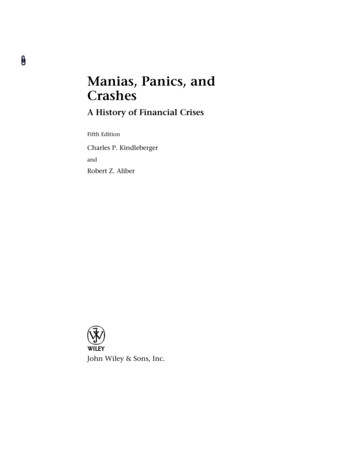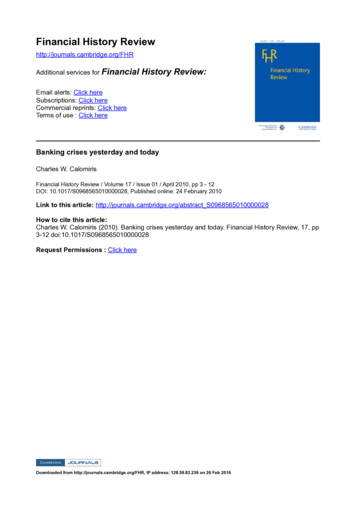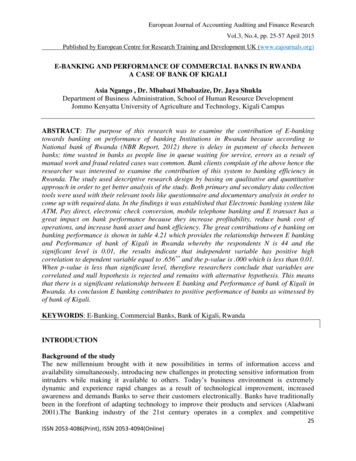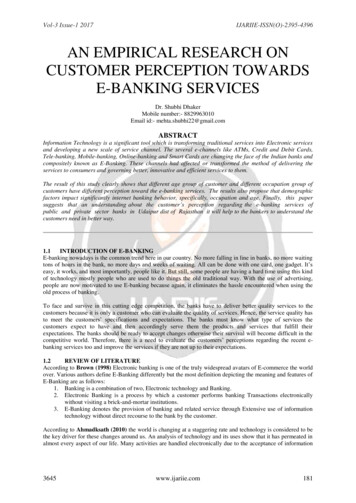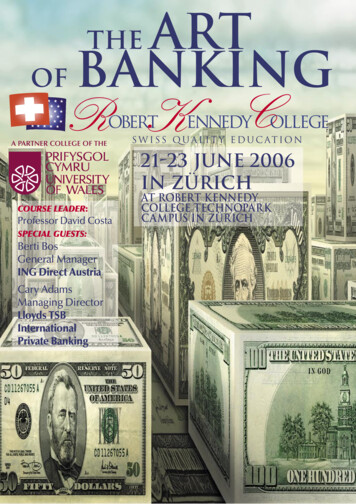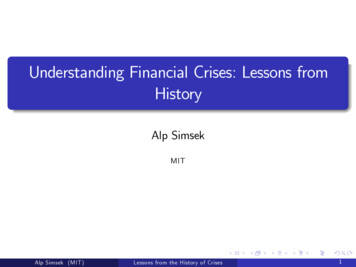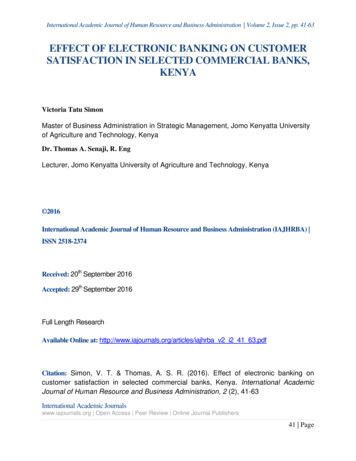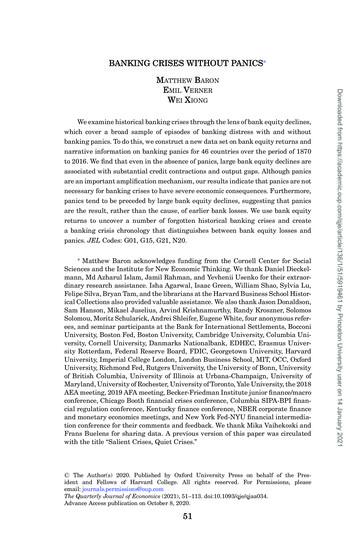
Transcription
BANKING CRISES WITHOUT PANICS We examine historical banking crises through the lens of bank equity declines,which cover a broad sample of episodes of banking distress with and withoutbanking panics. To do this, we construct a new data set on bank equity returns andnarrative information on banking panics for 46 countries over the period of 1870to 2016. We find that even in the absence of panics, large bank equity declines areassociated with substantial credit contractions and output gaps. Although panicsare an important amplification mechanism, our results indicate that panics are notnecessary for banking crises to have severe economic consequences. Furthermore,panics tend to be preceded by large bank equity declines, suggesting that panicsare the result, rather than the cause, of earlier bank losses. We use bank equityreturns to uncover a number of forgotten historical banking crises and createa banking crisis chronology that distinguishes between bank equity losses andpanics. JEL Codes: G01, G15, G21, N20. Matthew Baron acknowledges funding from the Cornell Center for SocialSciences and the Institute for New Economic Thinking. We thank Daniel Dieckelmann, Md Azharul Islam, Jamil Rahman, and Yevhenii Usenko for their extraordinary research assistance. Isha Agarwal, Isaac Green, William Shao, Sylvia Lu,Felipe Silva, Bryan Tam, and the librarians at the Harvard Business School Historical Collections also provided valuable assistance. We also thank Jason Donaldson,Sam Hanson, Mikael Juselius, Arvind Krishnamurthy, Randy Kroszner, SolomosSolomou, Moritz Schularick, Andrei Shleifer, Eugene White, four anonymous referees, and seminar participants at the Bank for International Settlements, BocconiUniversity, Boston Fed, Boston University, Cambridge University, Columbia University, Cornell University, Danmarks Nationalbank, EDHEC, Erasmus University Rotterdam, Federal Reserve Board, FDIC, Georgetown University, HarvardUniversity, Imperial College London, London Business School, MIT, OCC, OxfordUniversity, Richmond Fed, Rutgers University, the University of Bonn, Universityof British Columbia, University of Illinois at Urbana-Champaign, University ofMaryland, University of Rochester, University of Toronto, Yale University, the 2018AEA meeting, 2019 AFA meeting, Becker-Friedman Institute junior finance/macroconference, Chicago Booth financial crises conference, Columbia SIPA-BPI financial regulation conference, Kentucky finance conference, NBER corporate financeand monetary economics meetings, and New York Fed-NYU financial intermediation conference for their comments and feedback. We thank Mika Vaihekoski andFrans Buelens for sharing data. A previous version of this paper was circulatedwith the title “Salient Crises, Quiet Crises.” C The Author(s) 2020. Published by Oxford University Press on behalf of the President and Fellows of Harvard College. All rights reserved. For Permissions, pleaseemail: journals.permissions@oup.comThe Quarterly Journal of Economics (2021), 51–113. doi:10.1093/qje/qjaa034.Advance Access publication on October 8, 2020.51Downloaded from 461 by Princeton University user on 14 January 2021MATTHEW BARONEMIL VERNERWEI XIONG
52THE QUARTERLY JOURNAL OF ECONOMICSI. INTRODUCTIONDownloaded from 461 by Princeton University user on 14 January 2021The severe economic distress faced by the world economyfollowing the 2008 financial crisis has renewed interest inunderstanding the causes and consequences of banking crises.Academics and policy makers often emphasize panics amongbank creditors as a key driver of banking crises. As highlightedby the classic theory of Diamond and Dybvig (1983), using shortterm debt to finance long-term illiquid investments exposes evensolvent banks to self-fulfilling panics. Consistent with this theory,Friedman and Schwartz (1963) argue that depositor panicsplayed a central role in the severity of the Great Depression, andBernanke (2018) attributes the unusual severity of the GreatRecession primarily to the panics in funding and securitizationmarkets after the collapse of Lehman Brothers. As a reflectionof the influence of this panic-based view of banking crises, somehave gone as far as to define banking crises as essentially bankingpanics (Schwartz 1987; Gorton 2014).However, another strand of research on banking crises arguesthat policy makers should be concerned primarily by bank capitalcrunches driven by asset losses rather than banking panics perse (e.g., Calomiris and Mason 2003; Greenlaw et al. 2008; Admatiand Hellwig 2014). This alternative view is motivated by anextensive literature that emphasizes bank equity as a key statevariable that determines banks’ capacity to intermediate fundsfrom savers to firms and households (e.g., Holmström and Tirole1997; Gertler and Kiyotaki 2010; He and Krishnamurthy 2013;Brunnermeier and Sannikov 2014; Rampini and Viswanathan2019). According to these models, adverse shocks that impairbank equity may constrain banks’ capacity to finance the economy,depressing output through a bank capital crunch. As a result,an important debate remains about whether banking panics areessential to banking crises or whether large bank losses evenwithout panics can also translate into severe recessions.In this article, we take advantage of a large historical sampleof bank equity returns to systematically examine the role of banklosses and panics in banking crises. Our conceptual definition of abanking crisis is an episode in which the banking sector’s ability tointermediate funds is severely impaired. Because equity holdersare the first to suffer losses from a banking crisis that damagesbanks’ intermediation capacity, we assume that conceptually, alarge bank equity decline is necessary for a banking crisis. By
BANKING CRISES WITHOUT PANICS531. Panic-based runs tend to occur as discontinuous disruptions in credit markets. Bernanke (2018) provides a summary of credit market disruptions duringthe 2007–2008 U.S. financial crisis, highlighting that, as short-term credit-marketinstruments are by design information-insensitive during normal periods, it isdifficult for policy makers to predict panic runs on these instruments and theeconomic consequences of such runs.Downloaded from 461 by Princeton University user on 14 January 2021panics, we mean episodes of severe and sudden withdrawals offunding by bank creditors from a significant part of the bankingsystem. We assume that panics are a subset of banking crises,because not all banking crises necessarily feature panics.Large bank equity declines offer several advantages relativeto the existing approaches to studying historical banking crises(e.g., Reinhart and Rogoff 2009; Laeven and Valencia 2013). First,bank equity returns provide an objective, real-time, and quantitative measure to map out historical periods of bank distress and aretherefore not subject to lookback biases inherent in retrospectivenarrative approaches to identifying banking crises (Romer andRomer 2017). Second, large declines in bank equity cover a broadsample of episodes of banking distress with and without panics, asepisodes without panics may be otherwise hard to detect becauseof the “quiet” nature of some such episodes of bank distress. Third,as bank equity has the lowest payoff priority among bank stakeholders, bank equity returns are sensitive to bank losses regardless of whether a bank is close to or far away from insolvency. Bankequity declines can thus serve as a continuous measure capturingearly signs of banking crises for real-time policy making, in contrast to the information insensitivity of credit market instrumentsprior to panics.1 Fourth, the broad availability of bank equity returns across many countries going far back in time makes bank equity returns particularly appealing for studying historical crises.We construct a new historical data set of bank equity indexreturns for 46 advanced and emerging economies going back to1870, built in large part from hand-collected individual bankstock price and dividend data from historical newspapers. Wecontrol for broader stock market conditions by also constructingnew indices for nonfinancial stocks over the same sample. Ourdata set thus provides nearly 2,500 country-years of informationon bank equities, nonfinancial equities, and macroeconomic variables. We also collect new information on the occurrence of eventssuch as banking panics and widespread bank failures, backedby several hundred pages of narrative documentation. With this
54THE QUARTERLY JOURNAL OF ECONOMICSdata set of bank equity returns, we address the following researchquestions related to the aforementioned debate.2. Are panics necessary for banking crises to have severeeconomic consequences?. Bank equity returns allow us to addressthis central question, as large equity declines capture a sample2. By using bank equity declines as a convenient measure of banking distress, our analysis provides broad evidence of the macroeconomic consequences ofbanking distress across time and countries, complementing previous studies thatuse cross-sectional variation in specific episodes to offer sharp identification ofthe macroeconomic consequences of banking distress (Peek and Rosengren 2000;Khwaja and Mian 2008; Amiti and Weinstein 2011; Mehran and Thakor 2011;Puri, Rocholl, and Steffen 2011; Chodorow-Reich 2014; Huber 2018).3. Because the bank equity index contains measurement error, it may notfully capture the capitalization of the entire banking sector in a country for tworeasons. First, the bank equity index primarily covers large commercial banks andthus may not capture distress at private banks, regional banks, or nonbank financial institutions not included in the index. Second, the number of publicly tradedbanking institutions included in the index can be sparse in some countries andtime periods, as shown in Online Appendix Table B1. Despite this measurementerror, we show that the bank equity index still has strong predictive power formacroeconomic outcomes and is useful for identifying periods of banking distress.Downloaded from 461 by Princeton University user on 14 January 20211. Are large bank equity declines associated with adversemacroeconomic consequences? We begin by examining whetherbank equity index returns have predictive content for futuremacroeconomic dynamics, beyond the information contained innonfinancial equities. We find that bank equity declines predictlarge and persistent declines in future real GDP and bank creditto the private sector. For example, a decline in bank equity ofat least 30% predicts 3.4% lower real GDP and 5.7 percentagepoints lower bank credit-to-GDP after three years. The relationbetween bank equity returns and future output and credit growthis highly nonlinear: declines in bank equity predict future outputand credit contraction, whereas increases in bank equity donot predict stronger economic performance. In contrast, whilenonfinancial equity declines also separately predict lower GDP,they have no relation to subsequent bank credit-to-GDP. Largebank equity declines thus likely pick up episodes when outputcontracts in part due to troubles in the banking sector.2 As furtherconfirmation, we find that bank equity declines tend to captureother characteristics associated with banking crises, such aswidespread bank failures, high rates of nonperforming loans, andgovernment intervention in the banking sector.3
BANKING CRISES WITHOUT PANICS55Downloaded from 461 by Princeton University user on 14 January 2021of episodes of bank distress in which banks suffer large lossesfrom the viewpoint of equity investors. Since large bank equitydeclines include episodes of banking sector distress with andwithout banking panics, they allow us to separately examine themacroeconomic consequences of each type of episode. Bankingcrises without panics may occur when banks are undercapitalizedand their ability to lend is severely impaired, even when panicsby bank creditors are prevented, often due to a combination ofregulatory forbearance, implicit creditor guarantees, and forcefulgovernment interventions.To capture episodes of bank distress, we define a “bank equitycrash” as an annual bank equity decline of over 30%. We separatethese bank equity crashes into panic versus nonpanic episodesbased on a systematic reading of the narrative evidence for each ofthese episodes. We define panics as episodes of severe and suddenwithdrawals of funding by bank creditors from a significant part ofthe banking system, which could include withdrawals of fundingfrom insolvent banks or illiquid but fundamentally solvent banks.Our analysis finds that although bank equity crashes with panicstend to be followed by greater credit contractions and lower outputgrowth, bank equity crashes without panics also predict substantial credit contractions and persistent output gaps. For example,even in the absence of any creditor panic, a decline in bank equityof at least 30% predicts that after three years, bank credit-to-GDPdeclines by 3.5% and real GDP declines by 2.7%. This finding suggests that in a large historical sample, panics are not necessary forbanking sector distress to result in severe economic consequences.Although some nonpanic bank equity crashes might besolely driven by equity market noise, we show that many arewell-documented episodes in which the financial system sufferedmajor losses and was undercapitalized; yet strong regulatoryforbearance, implicit government guarantees, or outright government intervention prevented panics from emerging amongbank creditors. To stress their relevance, we highlight severalprominent episodes of severe nonpanic banking distress, including Canada during the Great Depression, Spain in 1977–1982,the United States in 1990–1992, Japan in 1990–1996 and 2001–2003, and several Eurozone countries in the years following theEurozone crisis—examples that are all associated with prolongedrecessions and credit crunches. Our analysis thus motivatespolicy makers to broaden their policy interventions to cover notjust panics in the banking system but also bank capital cruncheseven in the absence of panics.
56THE QUARTERLY JOURNAL OF ECONOMICS4. Our study thus complements the literature that links banking crises to priorcredit booms, which tend to go bust due to bad lending, leaving banks vulnerableto future losses that lead to bank capital crunches or even panics. Specifically, theliterature shows that credit booms predict a higher probability of banking crises(Schularick and Taylor 2012; Baron and Xiong 2017) and coincide with low creditspreads and an increase in debt issuance by riskier borrowers (Greenwood andHanson 2013; López-Salido, Stein, and Zakrajšek 2017; Mian, Sufi, and Verner2017; Krishnamurthy and Muir 2018). These findings highlight that elevated sentiment or overoptimism likely plays a central role in credit booms. Following aperiod of positive shocks, lenders may overextrapolate recent low defaults and neglect downside risk, leading to the underpricing of risk during the credit boom andsubsequent bank asset losses (Bordalo, Gennaioli, and Shleifer 2018; Greenwood,Hanson, and Jin 2019).Downloaded from 461 by Princeton University user on 14 January 20213. If panics occur, do they tend to precipitate the crisis or occurafter large declines in bank equity?: Bank equity returns allow forprecise analysis of the turning points of historical banking crisesand the dynamics of how crises evolve, as understood in real timeby equity investors. If panics are driven by self-fulfilling shocksunrelated to bank fundamentals, panics would not be preceded bybank equity declines. On the other hand, evidence of bank equitydeclines preceding subsequent panics suggests panics are relatedto prior bank losses rather than nonfundamental runs causingbank losses.Using monthly data covering over 100 banking crises, we findthat large bank equity declines tend to precede panics and creditspread spikes. On average, panics, as identified by narrativeaccounts, occur seven months after the bank equity index hasalready declined by 30%, suggesting that substantial bank lossesare already present at the early stages of these crisis episodes,as opposed to these losses being due to the subsequent panics.Furthermore, while credit spreads are relatively insensitive tothese early losses, bank equity, which has the lowest payoffpriority among bank stakeholders, is more sensitive to banklosses at the early stages of the crisis, highlighting bank equitydeclines as a useful crisis indicator for policy making in real time.Taken together, our findings paint a more complete pictureof the roles played by bank equity declines and panics duringbanking crises: large bank equity declines tend to be followed bysevere economic consequences even without panics; large bankequity declines precede panics; and panics with large bank equitydeclines tend to have the most severe credit contractions andoutput gaps.4 These findings highlight panics as an amplification
BANKING CRISES WITHOUT PANICS57II. DATAThis section describes how we gather and construct thehistorical database used in our analysis. We discuss the followingtypes of variables: bank and nonfinancial equity real totalreturns, bank and nonfinancial credit spreads, macroeconomicvariables, and narrative-based banking crisis chronologies. AllDownloaded from 461 by Princeton University user on 14 January 2021mechanism, but not a necessary condition for severe bankingcrises. Furthermore, these findings reinforce the importanceof timely recapitalization of bank capital during early phasesof banking distress, rather than having policy makers simplybackstop liquidity, to prevent subsequent panics from eruptingand to minimize adverse macroeconomic consequences.Finally, as a by-product of our analysis, we provide a refined chronology of banking crises that highlights both criseswith banking panics and crises with bank equity losses butwithout panics. Prior chronologies of historical banking crises,for example, Bordo et al. (2001), Caprio and Klingebiel (2002),Demirgüç-Kunt and Detragiache (2005), Reinhart and Rogoff(2009), Schularick and Taylor (2012), and Laeven and Valencia(2013), tend to be subjective in selecting banking crisis episodes(Romer and Romer 2017) and often disagree with one another.We use information from bank equity returns, along with newlycollected information on panics and widespread bank failures,to create a more systematic banking crisis chronology. Becausethere is no single correct definition of a banking crisis, our goalis to provide one possible construction of clear-cut crisis episodesbased on three systematic measures: bank equity losses, bankfailures, and panics. Importantly, our approach also removesspurious episodes from the previous narrative-based bankingcrisis chronologies and helps reconcile disagreements betweenthem. With the help of large bank equity declines as a screeningtool, we also uncover a number of “forgotten” historical bankingcrises that are confirmed by new narrative evidence.Our article is organized as follows. Section II describes ournew historical data set. Section III presents the results on theinformativeness of bank equity returns for macroeconomic outcomes. Section IV explores the macroeconomic implications of panics and nonpanic bank distress episodes. Section V compares thetiming of bank equity declines, panics, and other indicators aroundbanking crises, and Section VI presents our new crisis chronology.
58THE QUARTERLY JOURNAL OF ECONOMICSII.A. Annual Bank and Nonfinancial Stock ReturnsWe construct a new historical data set on bank equity pricesand dividends for 46 advanced and emerging economies goingback to 1870. A practical advantage of bank equity returns tostudy crises is that bank equity price and dividend data are readily available for much of our sample. This abundance of data is dueto the fact that in the nineteenth and early twentieth centuries,bank stocks were highly prominent, featured in newspapers, andtraded as much as railroad stocks.6 This contrasts with corporatebond and interbank lending spreads, as bond markets in manycountries have only been developed in recent decades.75. We exclude country-year observations during major wars because supplyside contractions and large government financing needs can lead to both macroeconomic contractions and banking sector losses, but these are not the typical bankingdistress episodes we want to consider. In particular, we drop all countries duringthe world wars (1914–1918 and 1939–1945), Colombia during 1899–1902, Franceand Germany in 1870, Greece during 1946–1949, Japan during 1894–1895, Koreaduring 1950–1953, Mexico during 1910–1920, South Africa during 1899–1902, andSpain during 1936–1938.6. In the period of 1870–1939, most of the major commercial banks in thecountries in our sample were publicly traded joint stock banks—with the UnitedStates being the main exception, where banks were not widely traded until themid-1920s. Private banks in this period were generally either merchant banks ormortgage banks, not commercial banks. We are thus able to gather the stock pricesand dividends of most large commercial banks in each country from historicalnewspapers during this period.7. In the postwar period, corporate bond markets mainly existed in theUnited States and the United Kingdom, while in most non-Anglophone advancedeconomies, corporate bond markets were very limited or nonexistent until deregulation in the 1980s (as corporate credit was channeled mainly through the bankingsystem). For example, there was only a single corporate bond trading in Denmarkand Japan before the 1980s (that of Det Store Nordiske Telegrafselskab and Nippon Telegraph and Telephone, respectively). Even organized interbank marketsare a relative recent phenomenon, with data becoming available for most countries starting in the 1990s. As a result, studies using credit spreads, such asKrishnamurthy and Muir (2018), analyze a more limited sample because they doDownloaded from 461 by Princeton University user on 14 January 2021variables are annual (except those noted as monthly variables)and form an unbalanced country panel across 46 countries overthe period of 1870–2016.5 The Online Appendix contains furtherdetails on data sources and data construction beyond what ispresented here, and Online Appendix Tables B2 through B4provide a comprehensive summary by country of all data sourcesused to construct the main variables.
BANKING CRISES WITHOUT PANICS59not have corporate credit spread data for emerging market countries—or even formany advanced economies (Denmark, Italy, France, the Netherlands, and Switzerland) in the modern period.8. In price-weighted indices, each stock is normalized to the same par value inthe initial year. Its weight in subsequent years is then determined by past returns.9. The nonfinancial equity index is constructed to represent a diverse set of important and large companies, mainly covering the following industries: iron andsteel, goods manufacturing, electrical equipment, textiles, chemicals, paper andpulp products, food suppliers and breweries, and retail. We exclude transportation stocks (railroads and shipping), commodity-related stocks (including mining),utilities, real estate companies, and foreign and colonial enterprises, due to theirhigh exposure to international factors or to real estate.10. Online Appendix Figure A1 provides examples of historical newspapersused to construct our bank equity return data. To give a sense of the sheer number and diversity of historical sources we uncovered, we list the main ones here(the full list is available in Online Appendix Table B2): Journal de Bruxelles forBelgium (1868–1935); Dagens Nyheder for Denmark (1868–1909); Le Temps forFrance (1873–1939); Berliner Borsen-Zeitung and Berliner Morgenpost for Germany (1871–1933); La Stampa for Italy (1865–1934); Japan Times for Japan(1897–1915); De Telegraaf and De Standaard for the Netherlands (1875–1933);Diario de Lisboa for Portugal (1921–1990); the Straits Times for Singapore (1965–1980); ABC for Spain (1909–1965); and Gazette de Lausanne, Journal de Genève,Downloaded from 461 by Princeton University user on 14 January 2021For each country in the sample, we construct annual (asof December 31 of each year) price return and dividend returnindices for both bank and nonfinancial stocks. In this paper, allequity returns (unless otherwise noted) are expressed as realtotal returns of the country-level index. The price and dividendindices in a given country may not necessarily correspond to thesame underlying banks due to data availability, but they areeither market-capitalization-weighted or price-weighted indicesof the broad domestic banking and nonfinancial sectors in eachcountry.8 Each series is pieced together from a variety of sources(documentation and source tables can be found in the OnlineAppendix).9 We start by collecting premade bank equity indicesfrom Global Financial Data (mainly price indices), Datastream(price and dividend indices), and Baron and Xiong (2017) (newlyconstructed bank dividend indices).In addition to using premade indices, we construct bankequity price and dividend indices from individual bank andnonfinancial companies’ stock prices and dividends. Our mainsource of new data on individual stocks is historical newspapersin each country. From these newspapers, we hand-collect pricesand dividends on an annual basis for the closing price closest toDecember 31.10
60THE QUARTERLY JOURNAL OF ECONOMICSLe Temps, and Neue Zürcher Zeitung for Switzerland (1852–1936). We also collect stock returns data from a variety of additional sources: Argentinian stockreturns data (1900–1935) from Nakamura and Zarazaga (2001); Belgian stockreturns data from the SCOB database (University of Antwerp, Belgium andAnnaert, Buelens, and De Ceuster 2012); Danish stock returns data (1911–1956)from Denmark Statistical Yearbooks; Finnish stock returns data (1911–1974) fromNyberg and Vaihekoski (2010); and Swedish stock returns data (1870–1901) fromWaldenström (2014).Downloaded from 461 by Princeton University user on 14 January 2021Data on individual stock prices and dividends of banks andnonfinancial firms also come from several databases from Yale’sInternational Center for Finance (gathered and made publiclyavailable by William Goetzmann and Geert Rouwenhorst), including Investor’s Monthly Manual data (1869–1934), New York StockExchange data (1800–1871), and St. Petersburg Stock Exchangedata (1865–1917). Other data on individual stock and index returns are from a variety of additional sources, including individualcountry studies and statistical yearbooks. We hand-collect additional dividend data for individual bank and nonfinancial stocksfrom Moody’s Bank & Finance Manuals (1928–2000) and fromindividual financial statements of banks accessed at the HarvardBusiness Library’s Historical Collections. We add the bank equityprice returns and dividend returns to get bank equity total returnsand then adjust by the consumer price index (CPI) for each country to get bank equity real total returns. Online Appendix FigureA3 plots the distribution of bank and nonfinancial equity returnsaround banking crises defined by narrative-based approaches.The bank equity returns data start around 1870 for advancedeconomies such as Australia, Austria, Belgium, Canada, France,Germany, Ireland, Italy, New Zealand, Sweden, Switzerland, theUnited Kingdom, and the United States and even for economiesthat are currently considered emerging markets, such as Argentina, Brazil, Egypt, Greece, Hong Kong, India, Mexico, Russia,and Ottoman Turkey. To assess the coverage of our bank index,Online Appendix Table B1 reports, for each country and decade,the number of underlying banks used to construct the bankequity return index, or, when premade indices are available, thesource of the premade index. The exact range of included banksvaries across countries and historical periods because of historicaldata limitations. However, as can be seen from Online AppendixTable B1 and the associated lists of individual constituentbanks (linked to in the Online Appendix), the bank equityindex generally contains a broad representation of the largest
BANKING CRISES WITHOUT PANICS61II.B. Monthly Stock Returns and Credit Spreads for Banks andNonfinancialsTo analyze the dynamics of how crises unfold, we focus on anewly constructed set of clearly identified banking crisis episodes,referred to as the BVX Crisis List and described in detail inSection VI. We construct monthly series in a three-year windowaround each crisis episode for the following four variables:bank equity index returns, nonfinancial equity index returns,bank credit spreads, and nonfinancial corporate credit spreads.Because of historical data availability limitations, the monthlydata are a smaller subset of the larger annual data set on bankequity returns and cover 132 episodes.The complete list of sources for monthly equity returns andcredit spreads for each country is recorded in Online AppendixTable B3. For monthly bank and nonfinancial equity data for theperiod of 1980–2016, we mainly use country-level indices fromDatastream, which cover nearly all 46 countries. For the period of1870–1979, due to the difficulty of hand-collecting monthly datafrom historical records, the monthly equity data are
system. We assume that panics are a subset of banking crises, because not all banking crises necessarily feature panics. Large bank equity declines offer several advantages relative to the existing approaches to studying historical banking crises (e.g., Reinhart and Rogoff 2009; Laeven and Valencia 2013). First,
